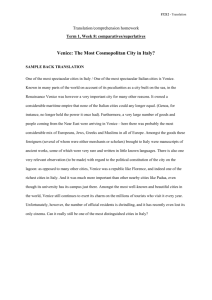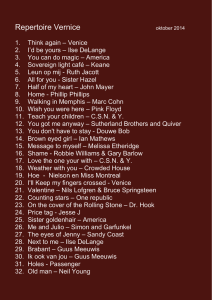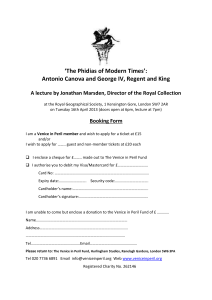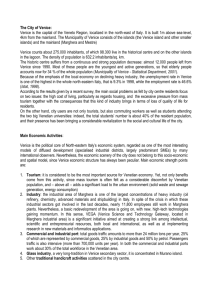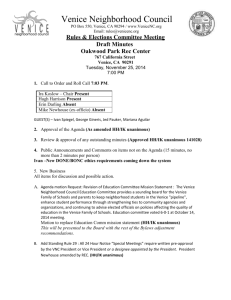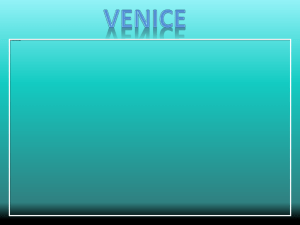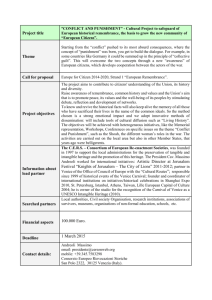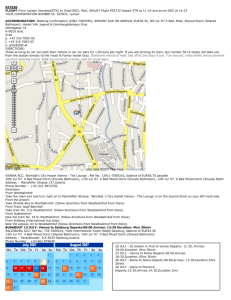The Essence of Italy - Reading Symphony Youth Orchestra
advertisement
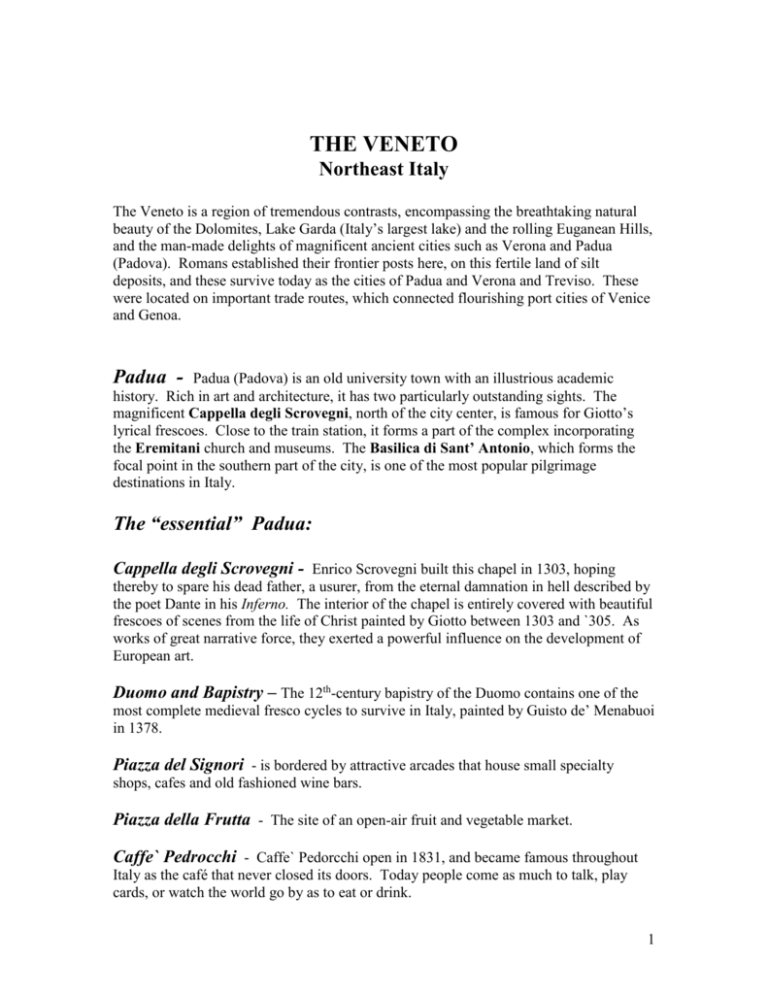
THE VENETO Northeast Italy The Veneto is a region of tremendous contrasts, encompassing the breathtaking natural beauty of the Dolomites, Lake Garda (Italy’s largest lake) and the rolling Euganean Hills, and the man-made delights of magnificent ancient cities such as Verona and Padua (Padova). Romans established their frontier posts here, on this fertile land of silt deposits, and these survive today as the cities of Padua and Verona and Treviso. These were located on important trade routes, which connected flourishing port cities of Venice and Genoa. Padua - Padua (Padova) is an old university town with an illustrious academic history. Rich in art and architecture, it has two particularly outstanding sights. The magnificent Cappella degli Scrovegni, north of the city center, is famous for Giotto’s lyrical frescoes. Close to the train station, it forms a part of the complex incorporating the Eremitani church and museums. The Basilica di Sant’ Antonio, which forms the focal point in the southern part of the city, is one of the most popular pilgrimage destinations in Italy. The “essential” Padua: Cappella degli Scrovegni - Enrico Scrovegni built this chapel in 1303, hoping thereby to spare his dead father, a usurer, from the eternal damnation in hell described by the poet Dante in his Inferno. The interior of the chapel is entirely covered with beautiful frescoes of scenes from the life of Christ painted by Giotto between 1303 and `305. As works of great narrative force, they exerted a powerful influence on the development of European art. Duomo and Bapistry – The 12th-century bapistry of the Duomo contains one of the most complete medieval fresco cycles to survive in Italy, painted by Guisto de’ Menabuoi in 1378. Piazza del Signori - is bordered by attractive arcades that house small specialty shops, cafes and old fashioned wine bars. Piazza della Frutta - The site of an open-air fruit and vegetable market. Caffe` Pedrocchi - Caffe` Pedorcchi open in 1831, and became famous throughout Italy as the café that never closed its doors. Today people come as much to talk, play cards, or watch the world go by as to eat or drink. 1 Chiesa degli Eremitani – The Eremitani church was built from 1276 to 1306 and contains magnificent roof and wall tombs. Basilica di Sant’ Antonio - The exotic church, with its minaret-like spires and Byzantine domes, is also know as Il Santo. It was built from 1232 to house the remains of St. Anthony of Padua, a preacher who modeled himself on St. Francis of Assisi. Although he was a simple man who rejected worldly wealth, the citizens of Padua built on of the most lavish churches in Christendom to serve as his shrine. VENICE Lying in the northeastern notch of Italy, Venice, gateway to the Orient, became an independent Byzantine province in the 10th century. Exclusive trading links with the East and victory in the Crusade of 1204 brought wealth and power, which were only gradually eroded by European the Turkish rivals. Today, Venice’s ties are with the local Veneto region, which stretches from the flat river plains to the Dolomites. Venice is one of the few cites in the world that can be truly described as unique. It survives against all the odds, built on a series of low mud banks amid the tidal waters of the Adriatic and regularly subject to floods. During the Middle Ages, under the leadership of successive doges, Venice expanded its power and influence throughout the Mediterranean. The immense wealth of the city was celebrated in art and architecture throughout the city. The riches of St. Mark’s alone bear witness to Venice’s position as a world power from the 12th to 14th centuries. After slowly losing ground to the new states of Europe, however, it fell to Napolean in 1797. Finally, Venice joined the Kingdom of Italy in 1866, so bringing unity to the county for the first time in its history. Today, Venice has found a new role. Her palazzi have become museums, shops, hotels, and apartments, and her convents have been turned into centers for art restoration. Yet, little of the essential fabric of Venice has altered in 200 years. The city’s sounds are still those of footsteps and the cries of boatmen. The only engines are those of barges delivering supplies or waterbuses ferrying passengers between stops. The same wellworn streets are still trod. More that 12 million visitors a year succumb to the magic of this improbable place whose “streets are full of water” and where the glories of the past are evident at every turn. 2 The “essential” Venice: The Grand Canal: Santa Lucia to the Rialto – The best way to view the Grand Canal as it winds through the heart of the city is from a vaporetto, or waterbus. Several lines travel the length of the canal. The palaces lining the waterway were built over a span of five centuries and present a panoramic survey of the city’s history, almost all bearing the name of some once great Venetian family. The Grand Canal: the Rialto to San Marco - After passing the Rialto, the canal doubles back on itself along a stretch known as La Volta (the bend). Ti then widens out and the views become more spectacular approaching San Marco. Facades may have faded and foundations frayed with the tides, yet the canal remains in the words of the French ambassador in 1495, “the most beautiful street in the world.” The Gondolas of Venice – The gondola has been a part of Venice since the 11th century. With its slim hull and flat underside, the craft is perfectly adapted to negotiating narrow, shallow canals. There is a slight leftward curve to the prow, which counteracts the force of the oar, preventing the gondola from going round in circles. In 1562, it was decreed that all gondolas should be black to stop people making an ostentatious show of their wealth. For special occasions they are decorated with flowers. Today, gondola rides are expensive and usually taken by tourists. However, traghetti (gondola ferries) are a cheap, convenient way of crossing the Grand Canal. Rialto Bridge – One of Venice’s most famous sights, the bridge offers fine views of the Grand Canal and marks the hear of the city. The Rialto takes its name from rivo alto (high bank) and was one of the first areas of Venice to be inhabited. A banking and then market district, it remains on of the city’s busiest and most bustling areas. Few visitors leave Venice without crossing the famous bridge. It is as wonderful place to watch and photograph the constant activity of boats on the Grand Canal below. Piazza San Marco - Throughout its long history Piazza San Marco has witnessed pageants, processions, political activities and countless Carnival festivities. Visitors flock here in their thousands for two of the city’s most important historic sights – the Basicica and the Palazzo Ducale. These magnificent buildings complement lesser sights, such as the Campanile, Museo Correr, and Torre dell’ Orogogio, not to mention open-air orchestras, elegant cafes and numerous smart shops. The Piazza was described by Napoleon as the “most elegant drawing room in Europe.” Basilica di San Marco – Venice’s famous basicilica blends the architectural and decorative styles of East and West to create one of the greatest buildings in Europe. The exterior owes its almost Oriental splendor to countless treasures from the Republic’s overseas empire. Among these are copies of the famous bronze horses, brought from Canstantinople in 1204, and a wealth of columns, bas-reliefs, and colored marbles studded across the main façade. Mosaics from different epochs adorn the five doorways, 3 while the main portal is framed by some of Italy’s loveliest Romanesque caring (124065). Campanile - From the top of St. Marks’s campanile, high above the piazza, visitors can enjoy the views of the city, the lagoon and, visibility permitting, the peaks of the Alps. The first tower, completed in 1173, was built as a lighthouse to assist navigators in the lagoon. Torre dell`Orologio - This richly decorated clock tower on the north side of the piazza was build in the late 15th century. According to a gruesome local ledend, once the clock was completed, the two inventors of the complex mechanism had their eyes gouged out to prevent them from every creating a replica. Harry’s Bar - Harry’s Bar as attracted American visitors since Guiseppe Cipriani and his friend Harry set it up in 1931. Ernest Hemingway was one of the bar’s many famous patrons. VERONA Verona is a vibrant trading center, the second biggest city in the Veneto region (after Venice) and one of the most prosperous in northern Italy. Its ancient center boasts many magnificent Roman ruins, second only to those of Rome itself, and a fine palazzi built of rosso di Verona, the local pink-tinged limestone, by the city’s medieval rulers. Verona has two main focal points: the massive 1st century AD Area, which is still the setting for major events, and Piazza Erbe with its colorful market. One of main attractions, however, is the church of San Zeno Maggiore that boasts unusual medieval bronze door panels: they are carved with extraordinary scenes, some biblical, others on the life of San Zeno. The “essential” Verona: Arena – Verona’s Roman amphitheater, completed in AD30, is the third largest in the world, after Rome’s Colosseum and the amphitheater at Santa Maria Capua Vetere, near Naples. The interior, still virtually intact, could hold almost the entire population of Roman Verona and visitors came from across the Veneto to watch gladiatorial combats, Since then, the Area has seen executions, fairs bullfights, and theater and opera productions. 4 Castelvecchio - This impressive castle, built by CangrandeII between 1355 and 1375, house one of the finest art galleries in the Veneto outside Venice. It is arranged to give striking views of the castle as well as the exhibits within. San Fermo Maggiore - San Fermo Maggiore is not one but two churches: this is most clearly seen from the outside where the apse has pointed Gothic elements rising above a sturdy Romanesque base. The lower church, begun in 1065 by Benedictine monks on the site of an earlier sanctuary, has frescoes on the simple arcades. The more impressive upper church dates from 1313 and is covered with a splendid ship’s keel roof. Piazza Erbe - Since the days of the Roman Empire, Piazza Erbe – built on the site of the ancient Roman forum – has been the center of Verona. Many of the city’s fine palazzi, churches and monuments are nearly as ancient, several dating from the medieval period. Piazza Erbe is named after the city’s old herb market. Today’s stands, shaded by umbrellas, sell everything from herb-flavored roast suckling pit in bread rolls to succulent fresh-picked fruit and delicious wild mushrooms. The fountain in the middle of the piazza is often overshadowed by the colorful market stands, though the statue at its center dates from Roman times. It serves as a reminder that this piazza has been used as a market place for 2,000 years. Piazza dei Signori - In the center of the square stands an elegant 19th century statue of Dante, whose gaze seems fixed on the forbidding Plazzo del Capitano, once the home of Verona’s military commanders. Beside it is the equally intimidating Palazzo della Ragione, the Palace of Reason, or law court; both were built in the 14th century. Behind the statue of Dante is the Loggia del Consiglio (1493), the council chamber topped by statues of Roman worthies born in Verona. Duomo – Verona’s cathedra was begun in 1139 and is fronted by a magnificent Romanesque portal. Teatro Romano - This theater was built in the 1st century BC; little survives of the stage area, but the semicircular seating area remains largely intact. Romeo and Juliet - The tragic story of Romeo and Juliet, two young lovers from rival families, was written by Luigi da Porto of Vicenza in the 1520’s and has inspired countless drams, movies, and ballets. At the Casa di Guilietta (Juliet’s house), No. 27 Via Cappello, Romeo is said to have climbed to Juliet’s balcony; in reality this is a restored 13th century inn. Crowds throng to see the simple façade and stand on the small marble balcony. The run-down Casa di Romeo is a few streets away in Via Arche Scaligeri. San Zeno Maggiore - San Zeno, built in 1120-38 to house the shrine of Verona’s patron saint, is the most ornate Romanesque church in northern Italy. 5 LAKE GARDA Garda, the largest and easternmost of the Italian lakes, borders three regions: Trentinto to the north, Lombardo to the west and south, and Veneto to the south and east. The lowlying countryside around the southern stretches becomes increasingly dramatic further north, until impressive rocky cliffs, sometimes swathed in pines, hug the shoreline of the northern tip. The numerous sporting facilities, many sights and splendid scenery of snow-capped mountains help make the lake a favorite summer playground. 6
